- 30 Apr 2024
- 9 Minutes to read
- Print
- PDF
All Customers & Customer details
- Updated on 30 Apr 2024
- 9 Minutes to read
- Print
- PDF
Introduction
Customers within Joblogic are one of the foundations of the system, you will find a lot of what you do within Joblogic will relate to a customer in one way or another.
This guide will show you how to find customer records in your system and how to integrate the record to find history behind a specific customer and make updates to the record itself.
Before we get started, it is important to understand what a customer is and why they are a fundamental to the use of Joblogic. A customer is essentially a billable address, not necessarily where we are sending the engineer to carry out the works, but where we want the invoice to go once the work is done.
The customer is a mandatory field when creating jobs, PPM Contracts & quotes. Your customer record might have many sites linked to it, but it also might have a 1 to 1 relationship with a site, like a residential home.
Your customer base can be added to the system in a few ways:
- Create them individually using the ‘Add Customer’ function.
- Syncing them through from either Xero or Quickbooks
- Import via an Excel CSV
Now that your customers are loaded onto Joblogic, you are ready to search for these customers and look into the records.
Accessing the Customer Desk
To access the customer desk, you simply need to navigate to the modules pane on the left hand side of the screen. Click into ‘Customers’ and you will see ‘All Customers’.

Navigating the Customer Desk
Now that you have access to the customer desk, it's time to start looking around. You will find that the customer desk is very much similar to every other search page within the system. Once you have familiarized yourself with the customer desk, you will be able to use other desk’s in the system with ease. The only difference you will see going page to page are the different filters you have available to search by.
Filters
Search Customers – This is a free type search bar, allowing you to free type either the Name, Address, Contact Details, Reference number, Account number or Account manager assigned to that record.
NOTE that you do not have to type the full word into the search bar to bring results. For example, if you only knew the first 3 characters of a post code, you could type these in and Joblogic will show you every record that contains these.
You can also search for multiple fields in one go. For example, you could search for the contact name and a post code to reduce the results shown on the screen.
Tags – You will find Tags every where in the system, including against a customer record. A Tag is simply a label that you can apply to a customer record to allow you to search for it later. An example of this would be that I could tag a group of customers as ‘Gold Package’’. This would then allow me to search for this tag later and the system would show me all of my Gold Package customers.
The TAG filter is found within the ‘Show Advanced’ button on the page.

Action buttons
- Add Customer – This is one way you can create a new customer in your system. Simply click on it and fill out the form. Once saved it will be a record in your system.
- Print – Allows you to Print your search results to paper or to a PDF.
- Import – This is where you can get the import template from and upload your completed import template.
- Export – This button, similar to print, allows you to export your results into a CSV (Excel) file.

Results Table
The main part of the page is your results table. This will update based on the filters you have applied.
Tabs
There are three tabs to help you view your data more easily.
- Active – This will show you all of your customers marked as ACTIVE.
- Suspended – Will show you any customers you have marked as INACTIVE
- All – Will show you both active and inactive customers.
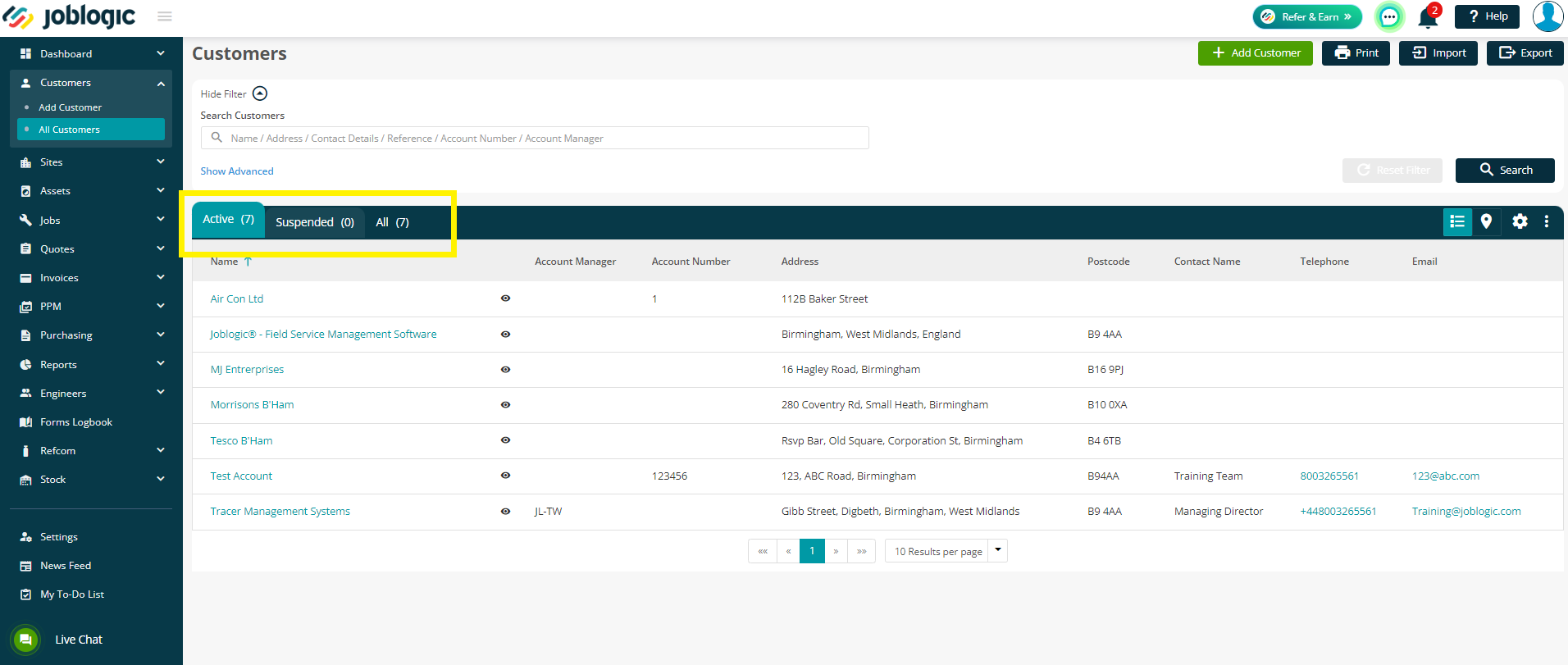
Further Actions
We also have 4 more buttons to the right of the screen which include 2 different view functions, a settings cog and a menu button.
- List view – This is the default view when you open up the customer desk. It simply shows you all customers based on your filters, in a list view.
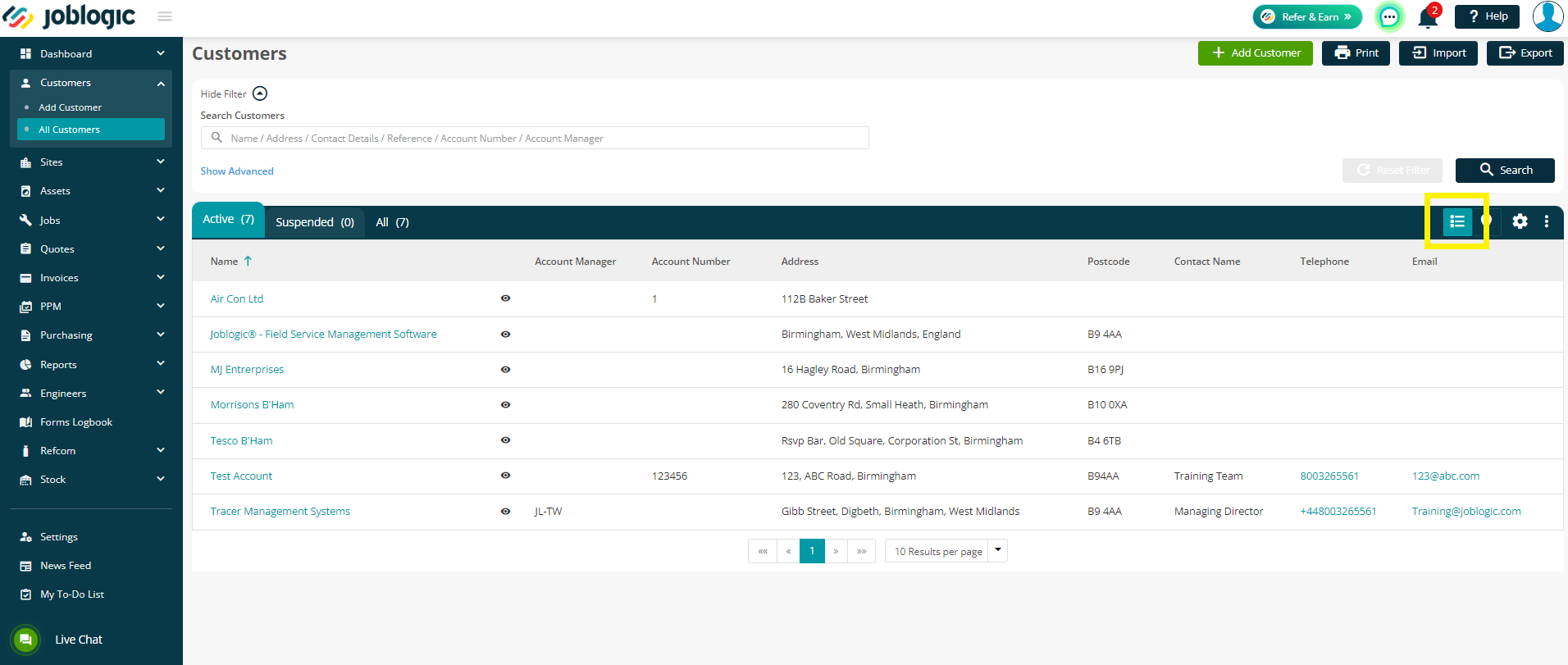
- Map view – Allows you to view your customer records on a map. Joblogic uses the address you have assigned to the customer to show it on a map. If the address is incomplete or incorrect it will now show.
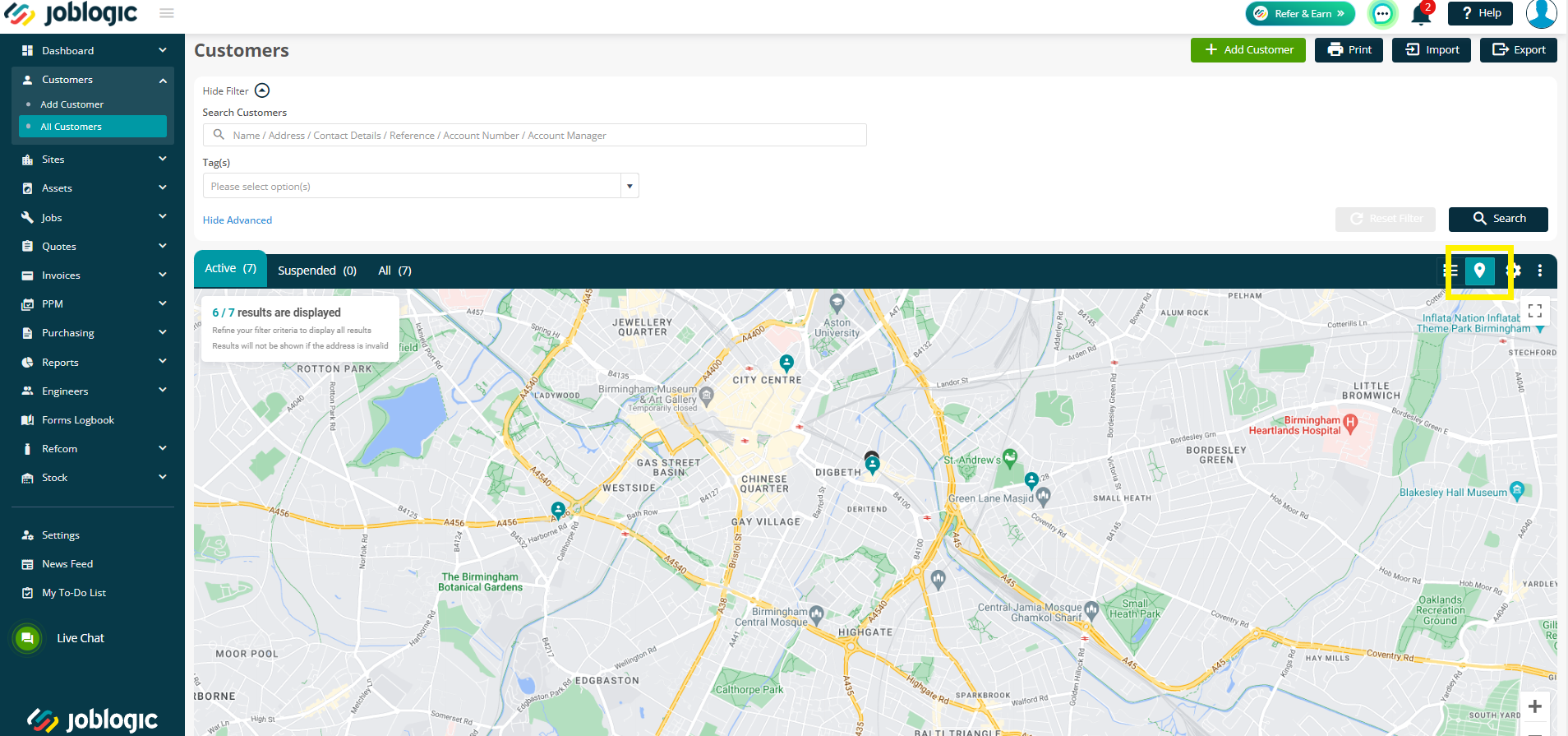
Settings cog – Here you can pick and choose what headers you see in your results table. As an example, if you’re not interested in the Account Number field, you can untick this and it will not show in the table.
Please note that these are user specific, so any changes you make in the cog will only update your profile.
You can also choose the order in which your headers show by dragging and dropping them into different orders.

- Menu – This is where you can Batch delete customers. You will notice that this is greyed out with no selection. To use this tool you need to apply either a tag or a search filter to batch delete.
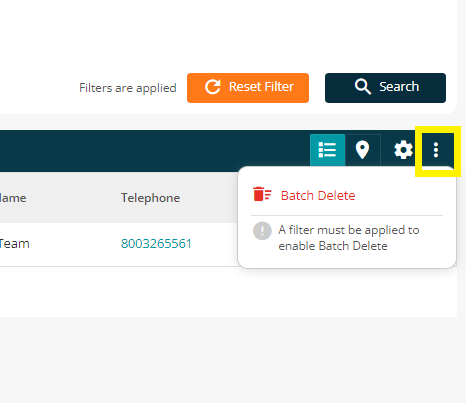
Main table
The results table itself will show you key client information at a glance. You will notice a few of the columns are hyperlinked (show in blue), this means that they are interactive:
- Name – Clicking on the Customer name will take you to the Customer Details page.
- Telephone – Clicking on the phone number allows you to call that number directly from your Joblogic system (Note that you need a soft phone application to do this)
- Email – Clicking on the email address will open a new email window to email that contact.
You will also find an eye icon next to the Customer name. This will open up a quick view screen, on the right-hand side, to show you some more key data without having to go into the record itself.
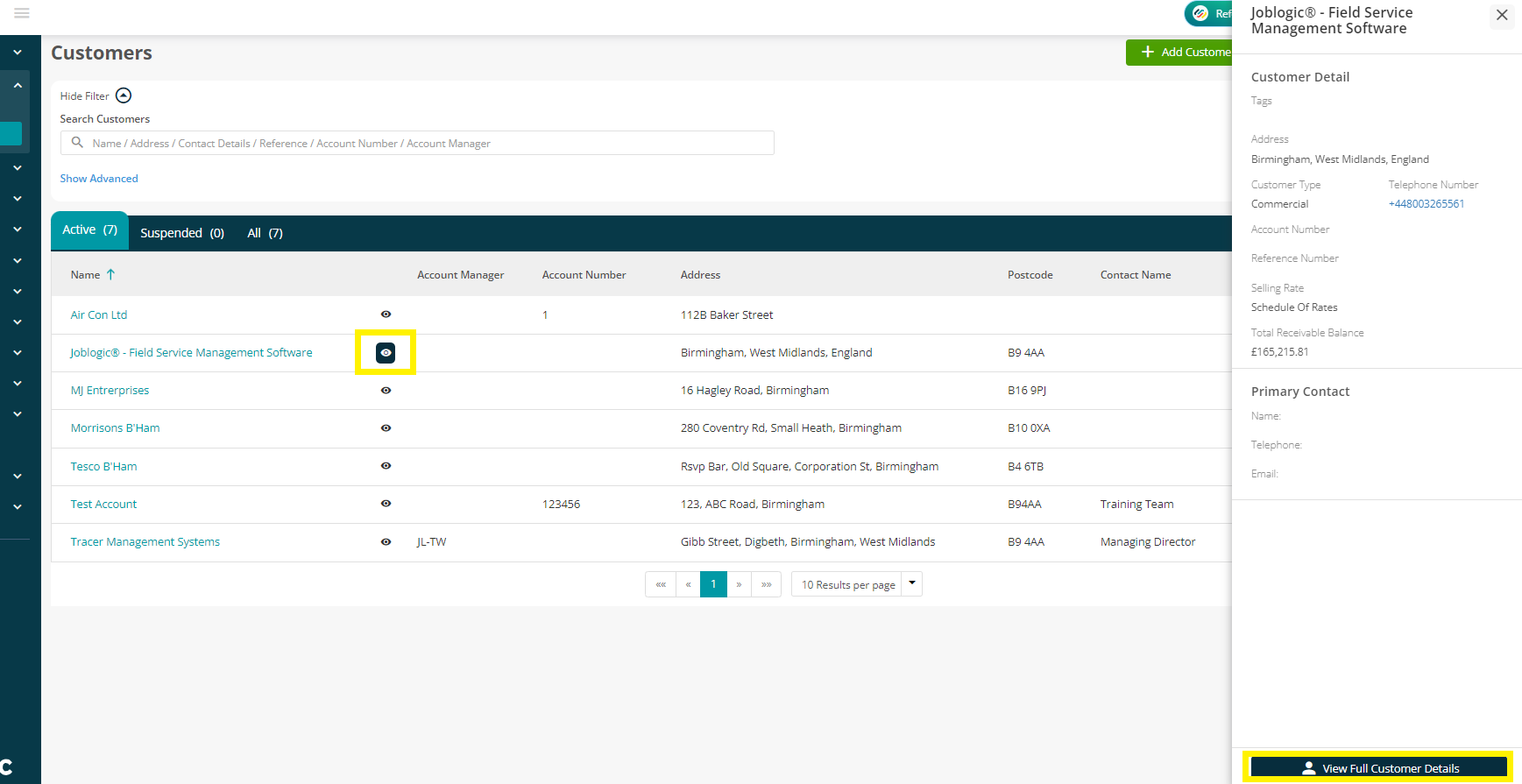
The Customer Record
As above, click the Customer Name to view an individual customer account.
Details
On this details page you can see the information that has been added to the customer record, including assigned Tags, Customer Type, Address information and the Contact Details.
All of this detail can be amended at any time, by clicking the edit button to unlock the page. Make your changes and then click Save at the bottom of the page.
You can also mark customers as inactive on this page. Marking a customer as inactive will move them to the suspended tab on your customer desk.
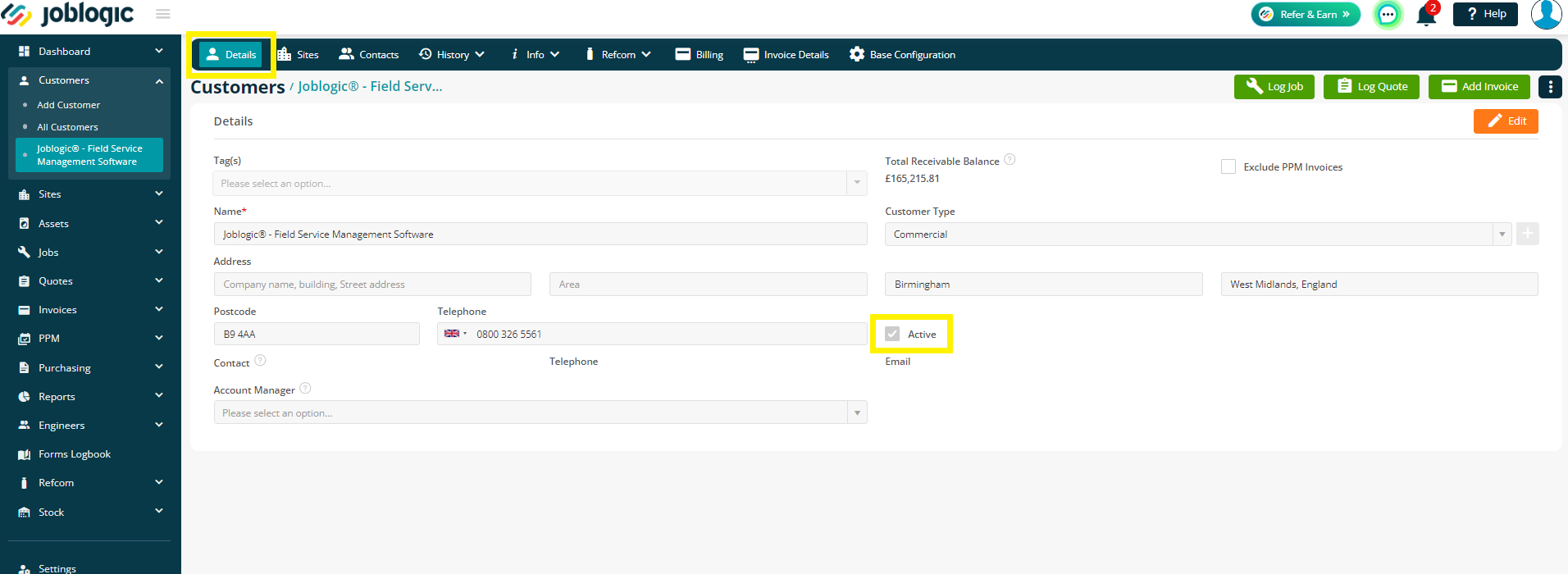
Sites
Within the Sites tab, you will see all sites that are related to this customer.
As mentioned above, the customer is the billable address and the site is where you go to do the work.
You can also Add or Import sites to this customer, on this screen.
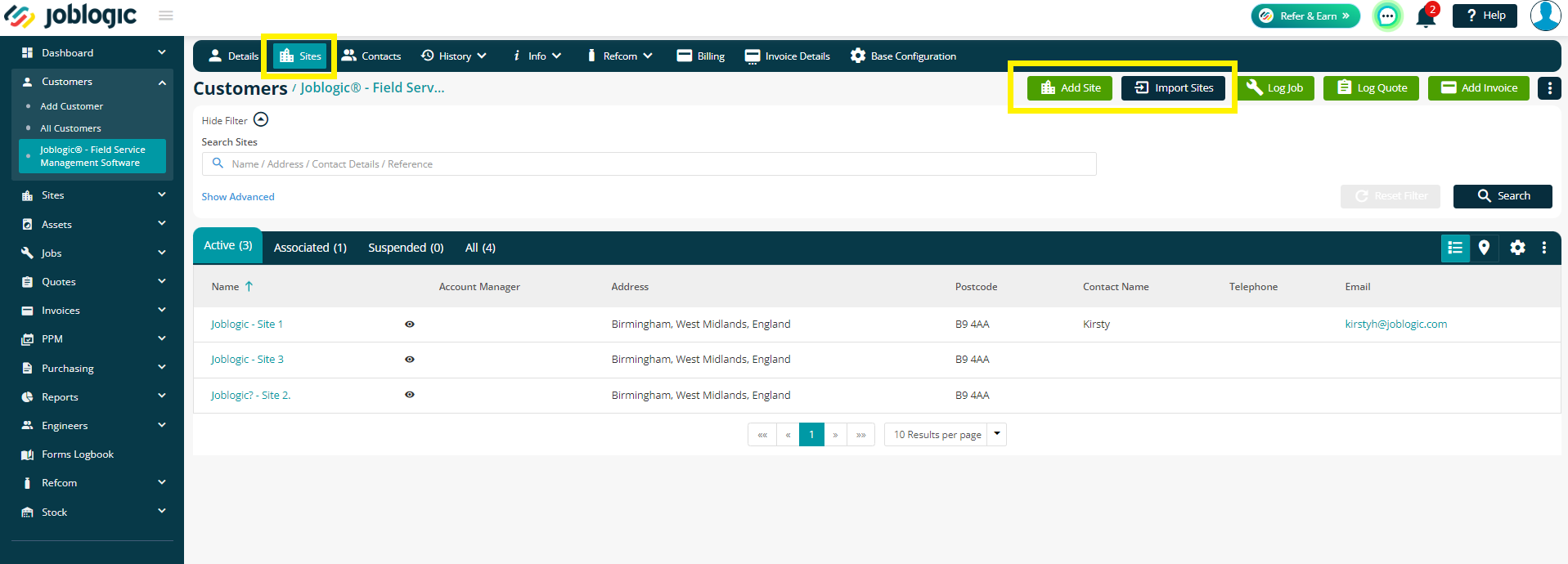
Contacts
This is where you can view or add contacts at Customer level.
They will then be selectable when raising jobs/quotes for this customer.

History - Jobs
Within this section of the History tab, Joblogic will show you every job you have created for this customer only. It’s a great place to come if you need to quickly find a job relating to this customer.
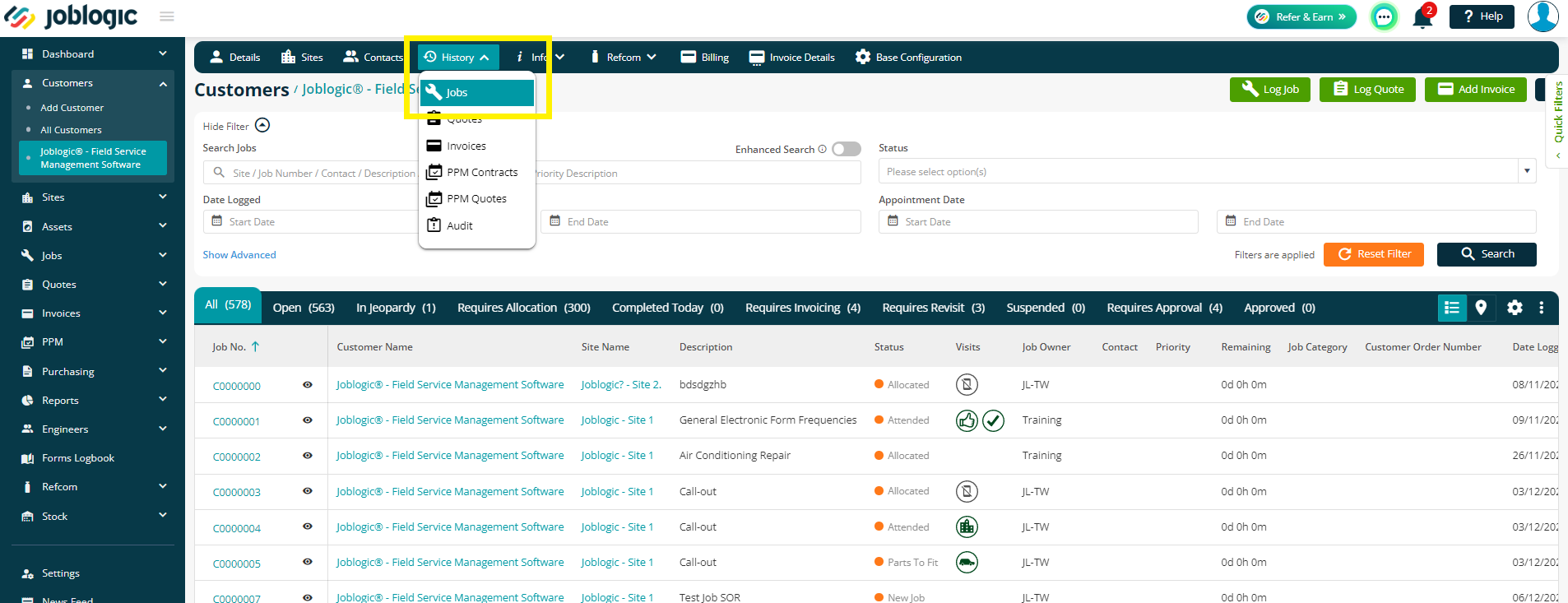
History - Quotes
Here you will find all quotes you have raised for this customer. Similar to Jobs, it’s a nice easy place to get the full list of quotes for this customer only.

History - Invoices
This screen will show you all Invoices raised against this Customer.
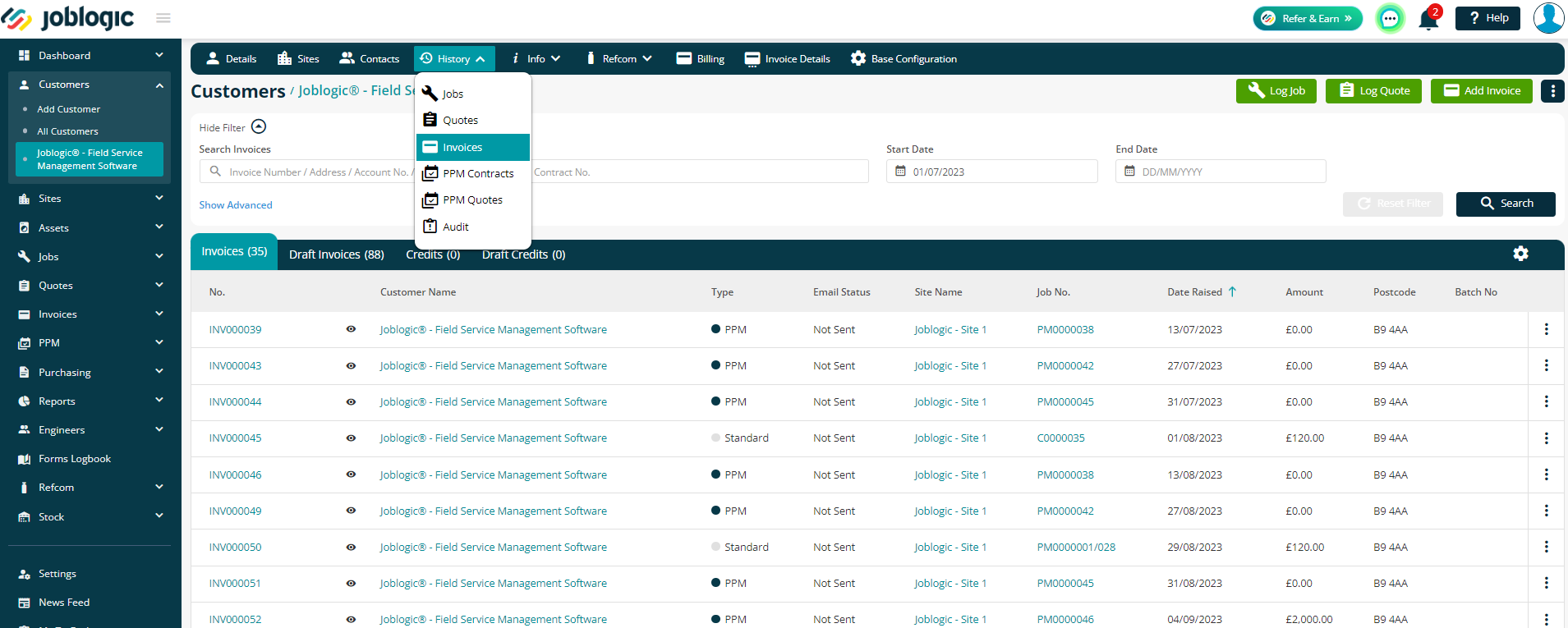
History - PPM Contracts
Here you will find all Contracts including In Progress, Completed & Suspended.

History - PPM Quotes
A place to come to quickly find all PPM Quotes you have raised for this Customer.

History - Audit
Any changes you make to a customer record are tracked. In this section of the customer record you will find a list of all changes that have been made with a name, a time stamp and details of what was changed.
To see the details of what was changed, click the Audit Type description.
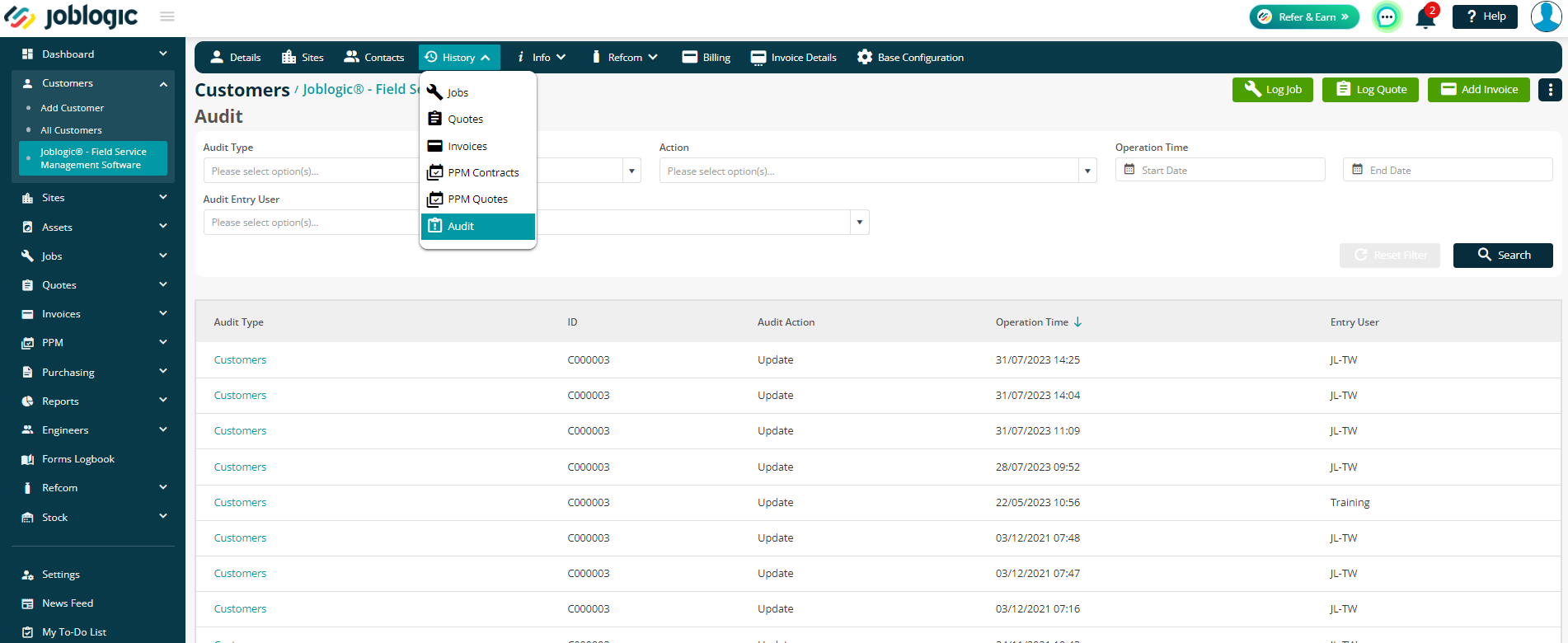

Info - Notes
Here, you can view or add Notes, Attachments and Links that are specific to the Customer account.
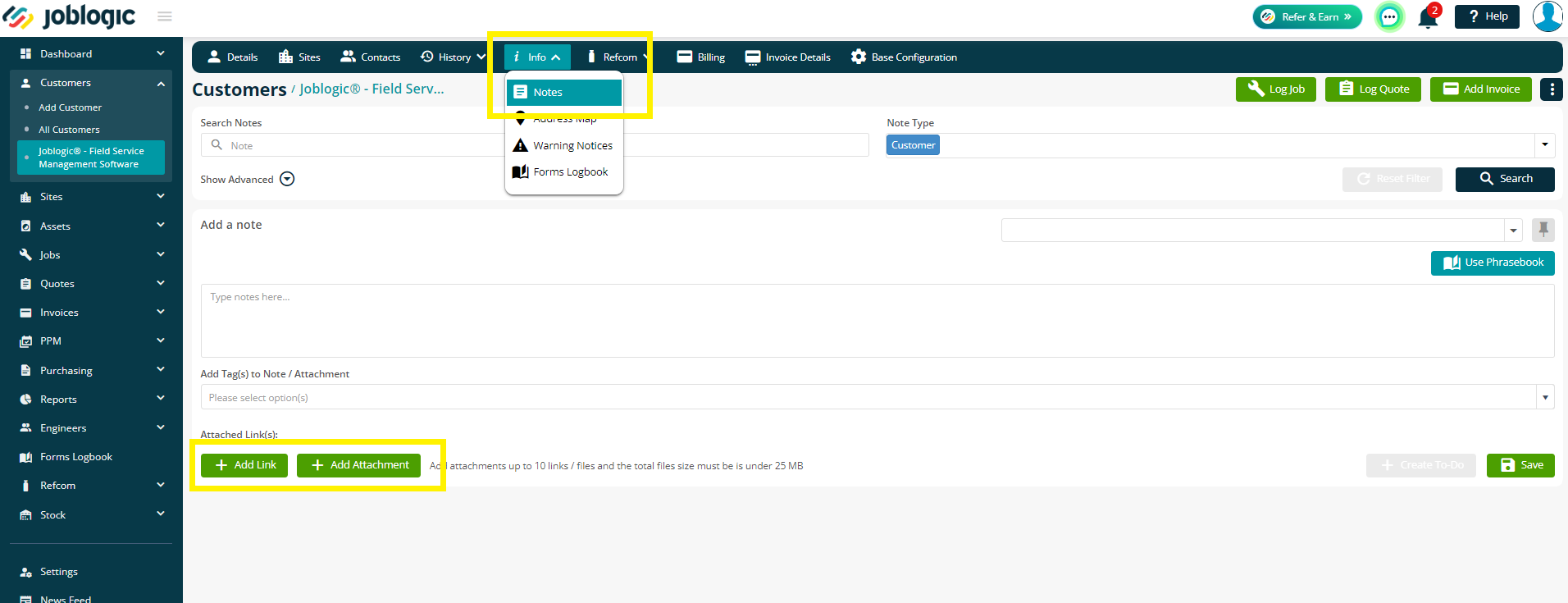
Info - Address Map
This will show you a Map view of your Customer Address, if the address details are complete and correct.

Info - Warning Notices
Warning Notices can be added to a Customer Record to inform yourself, or other colleagues, including your engineers, about anything important.
The notices will show up anytime you look at this customer record and anything relating to the customer, such as jobs or quotes.
To add the details, click Edit and then tick the Show button to make sure it pops up on all relevant pages.

Info - Forms Logbook
This page is a handy list of all forms completed by your engineers, for this customer.
You can easily view, download or mark forms as Private.

Refcom - Refcom Audit
If you are using the Refcom module within Joblogic, you can come here to see the full audit for this customer only, rather than going job by job.
This will include any actions that have been completed such as, additions, leak checks, corrections, etc.
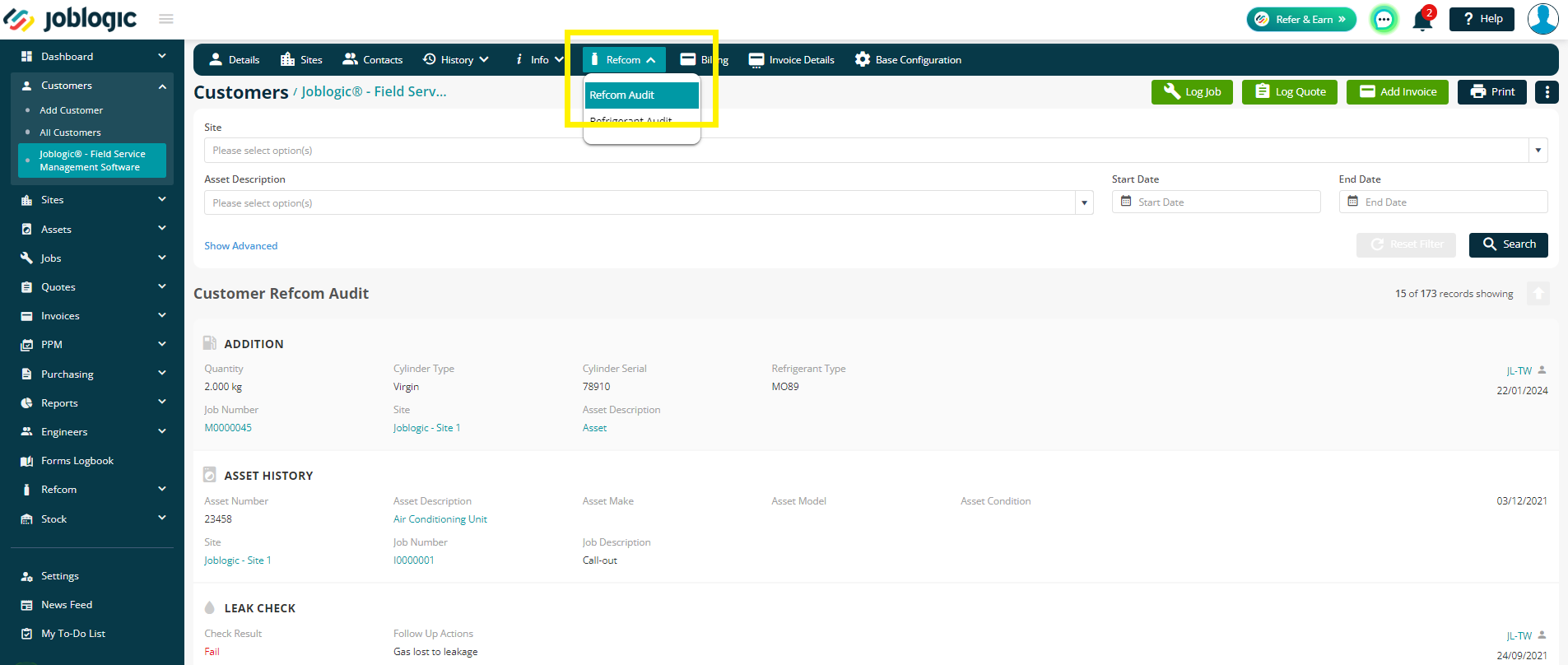
Refcom - Refrigerant Audit
Come here to view all of this customer’s audit details on refrigerant.
This will show you an audit specific to your refrigerant types and their total charges, etc.

Billing
Joblogic will assume that the customer address is the billable address. If for whatever reason the customer address is NOT the billable address, then this is where you come to add and enable a separate billing address.

Invoice Details
When doing your initial set up, you may have entered your default payment terms (Settings > System Setup > Invoice Details).
If you require a different option for a certain customer, you can do this via the Invoice Details tab on their page.
Leaving this page blank will mean Joblogic will use the system default.

Base Configuration
Similar to the above invoice details, Joblogic will use all of your default set up configurations within system settings if this section is left blank.
Within the configuration section of the customer record you can arm this customer record with its own defaults, saving time when raising jobs/invoicing/quoting.
You will find there are many defaults you can apply at a customer record on this page so take a look through these and tell Joblogic exactly how this customer should work to save you time when using the system going forward.
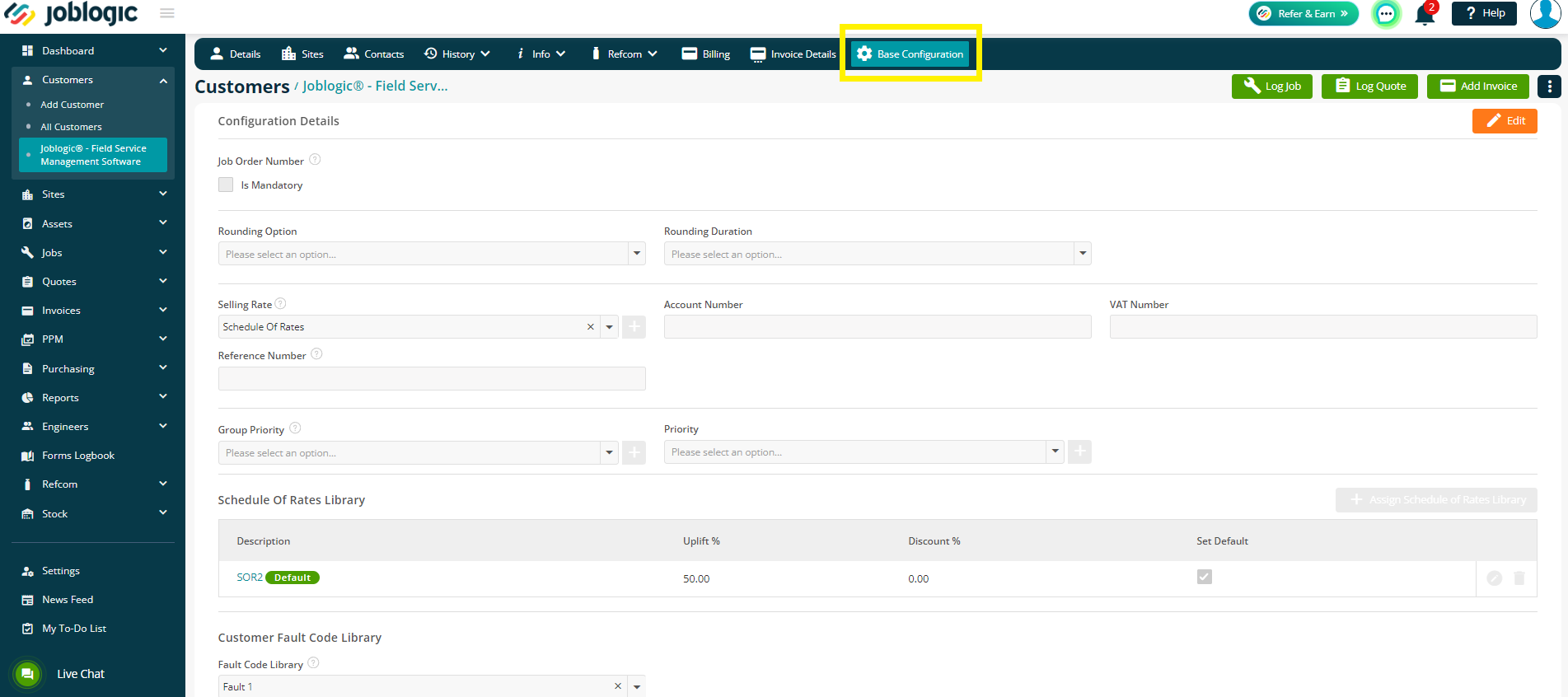
Further Support
For further information or assistance with the above, contact our Support Team on 0800 326 5561 or email support@joblogic.com. Alternatively, our Customer Success Management team can be reached by emailing customersuccess@joblogic.com
Publishing Details
This document was written and produced by Joblogic’s Technical Writing team and was last updated on the date specified above. Be aware that the information provided may be subject to change following further updates on the matter becoming available. Additionally, details within the guide may vary depending on your Joblogic account’s user permissions.

